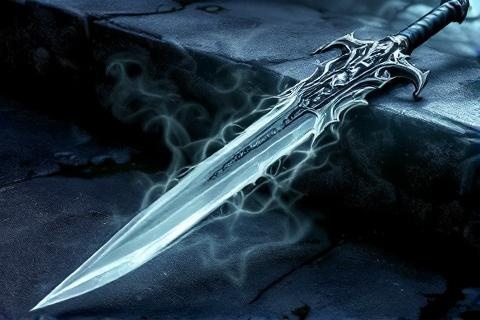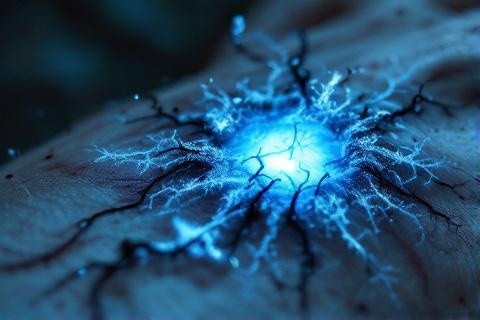
Morgul-blade: The Wraiths' Poisoned Weapon
A Deadly Dagger from the Shadows
Origins in the Dark Arts

The Morgul-blade's origins can be traced back to the fell realm of Minas
Morgul, once the fair city of Minas
Ithil. After the Nazgûl captured and
corrupted the Tower of the Moon in Third Age 2002, they
established their dark fortress there and began crafting weapons of terrible
power. These ancient weapons represented the perversion of what was once a
center of Gondorian knowledge and craft into a place of evil
and corruption.
The creation of Morgul-blades involved complex and malevolent enchantments that
drew upon the darkest aspects of sorcery. The Nazgûl, being powerful sorcerers
before their transformation into wraiths, imbued these weapons with spells of
fear, shadow, and domination. The process required rituals that corrupted the
very metal of the blades, making them vessels of evil will.
The primary purpose of these weapons was to create new servants for
Sauron by transforming their victims into wraiths. This
aligned with Sauron's strategy of corrupting and dominating rather than simply
destroying his enemies. The blades were specifically enchanted to extend the
Dark Lord's power by adding to his forces of shadow-bound servants.
Physical Description
The physical form of a Morgul-blade was distinctive in its deadly elegance.
These weapons were crafted as long daggers with needlessly cruel points,
designed to inflict maximum damage while delivering their dark enchantments. The
blades were thin enough to break off in their victims, yet strong enough to
pierce deeply.
Witnesses described Morgul-blades as having an otherworldly appearance that
inspired terror. They gleamed with a sickly pale light that seemed to draw from
and intensify nearby shadows. The cold radiance they emitted was unlike any
natural illumination, serving as a visible manifestation of their evil nature.
The surfaces of these weapons bore inscriptions of dark significance. Ancient
runes of power and malevolent symbols were etched into the metal, each
contributing to the blade's fell purpose. These markings were not mere
decoration but integral components of the weapon's enchantment, focusing and
channeling its evil properties.
Perhaps the most insidious aspect of the Morgul-blade's physical properties was
its ability to break and dissolve after wounding its victim. Upon striking its
target, the blade would splinter, leaving only the hilt in the wielder's hand
while the shards worked their way through the victim's flesh. This
characteristic made the wounds particularly difficult to treat, as the weapon
itself would vanish, leaving its evil work to continue unseen.
Magical Properties

The Morgul-blade's primary enchantment caused it to shatter upon striking its
victim, with the fragments beginning a terrible journey toward the heart. These
splinters moved of their own accord, driven by evil will rather than any natural
process. Each fragment carried the blade's full enchantment, making the weapon's
effects nearly impossible to counter without immediate intervention.
The curse laid upon these weapons was among the most terrible in
Middle-earth. Victims struck by a Morgul-blade would
gradually transform into wraiths, becoming invisible to mortal eyes and entering
the shadow realm where the Nazgûl dwelled. This transformation would bind them
forever to the will of Sauron, making them slaves to his dark purposes.
Wounds inflicted by Morgul-blades resisted normal healing arts. Even the most
skilled healers found these injuries challenging, as they were caused by both
physical and spiritual corruption. The wounds would remain cold to the touch and
continue to cause pain long after they were inflicted.
Those struck by these weapons reported an intense and persistent cold that
seemed to spread from the wound throughout their entire body. This supernatural
chill was more than physical discomfort; it represented the victim's gradual
slide into the wraith-world. The cold would intensify as the transformation
progressed, serving as a marker of how far the curse had advanced.
The Wraith Process
The transformation process inflicted by a Morgul-blade was gradual but
inexorable without intervention. Victims would slowly become transparent to
mortal eyes as they faded from the physical world. Their form would become
increasingly difficult to perceive in the normal world while becoming more
visible in the shadow realm.
As the victim's transformation progressed, they would fall under the dominion of
Sauron, their will becoming bound to his. The process would eventually complete
with the victim becoming a lesser wraith, forever enslaved to the Dark Lord's
commands. This fate was considered worse than death by the free peoples of
Middle-earth.
The progression of symptoms included an increasing sensitivity to light and a
growing affinity for darkness. Victims would experience the world around them
dimming as if in twilight, while simultaneously gaining the ability to perceive
the shadow realm with growing clarity. This dual awareness caused great distress
as the victim straddled both worlds.
Known Victims and Encounters

The most famous instance of a Morgul-blade's use occurred on Weathertop in
October of Third Age 3018, when the Witch-king of Angmar struck Frodo Baggins
during the Quest of the Ring. The Hobbit was wounded while
attempting to resist the Nazgûl's attack, receiving a grievous injury to his
left shoulder that would trouble him for the remainder of his life.
Aragorn's quick response and knowledge of
herb-lore proved crucial in preventing Frodo's immediate decline. His experience
as a Ranger and healer allowed him to slow the weapon's effects through the
application of athelas and other remedies. Without his intervention, Frodo's
transformation would have progressed much more rapidly.
The ultimate salvation of Frodo came through the healing powers of Lord Elrond
in Rivendell. Elrond's abilities as both a master healer and wielder of one of
the Three Elven Rings enabled him to remove the
splinter of the Morgul-blade that had been working its way toward Frodo's heart.
This intervention prevented the Hobbit's complete transformation into a wraith,
though he would carry the effects of the wound for the rest of his life.
Countermeasures and Healing

Athelas, also known as kingsfoil, served as the primary treatment for wounds
inflicted by Morgul-blades. This humble plant possessed remarkable healing
properties when properly prepared, particularly in the hands of those with
Númenórean heritage. Its effectiveness against the Black
Breath and similar evil influences made it especially valuable in treating
Morgul-wounds.
Complete healing of Morgul-wounds required the advanced healing arts of the
Elves, particularly those who possessed great power and wisdom.
Their understanding of both the physical and spiritual realms allowed them to
combat the weapon's evil enchantments. The healing process often involved
complex rituals and the application of powers that went beyond conventional
medicine.
The treatment of Morgul-wounds was extremely time-sensitive, with the victim's
chances of recovery diminishing rapidly as time passed. Each hour that elapsed
brought the victim closer to complete transformation, making swift action
essential for any hope of recovery. The journey to reach appropriate healing was
often as dangerous as the wound itself.
Even after successful treatment, victims of Morgul-blades never fully recovered.
They carried permanent reminders of their brush with the shadow realm, often
experiencing recurring pain and cold sensations, particularly on the
anniversaries of their wounding. These lasting effects served as a testament to
the weapon's terrible power.
Legacy in Middle-earth
The Morgul-blade stood as a powerful symbol of the Nazgûl's ability to corrupt
and transform the world around them. Just as they had turned the fair city of
Minas Ithil into the dread tower of Minas Morgul, their weapons represented the
power to twist and pervert the natural order of Middle-earth.
These weapons were considered among the most fearsome examples of evil
enchantment in the Third Age. Their ability to inflict both physical and
spiritual harm, combined with their purpose of expanding Sauron's dominion
through corruption rather than simple destruction, marked them as particularly
insidious tools of the Enemy.
The legend of the Morgul-blade persisted long after the War of the Ring, serving
as a cautionary tale about the dangers of evil artifacts and the importance of
resisting corruption. Stories of these weapons continued to inspire fear and
fascination among the peoples of Middle-earth, even after the defeat of Sauron
and the departure of the Nazgûl.
